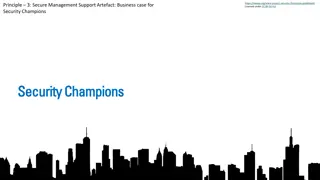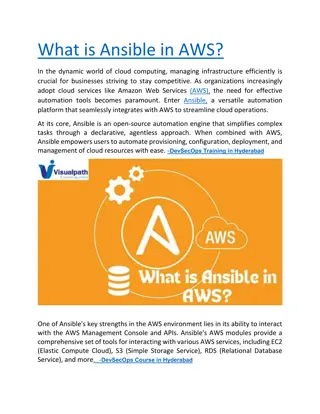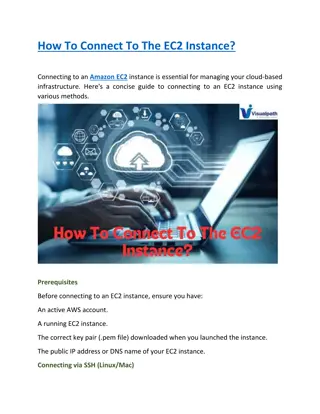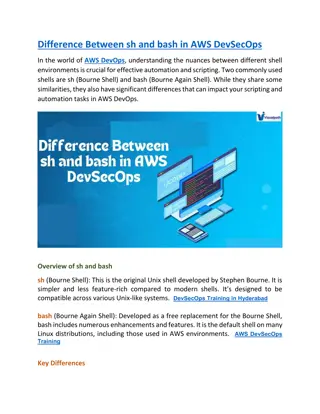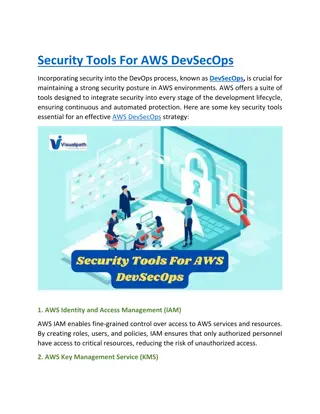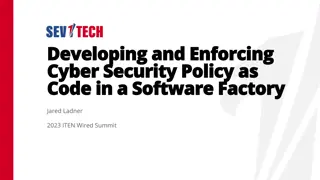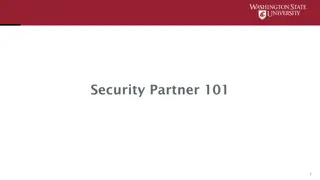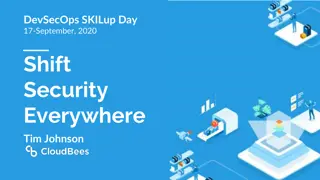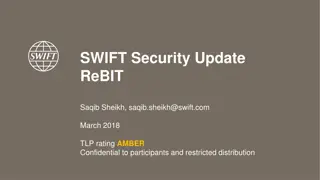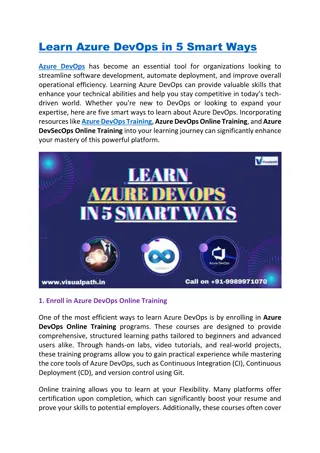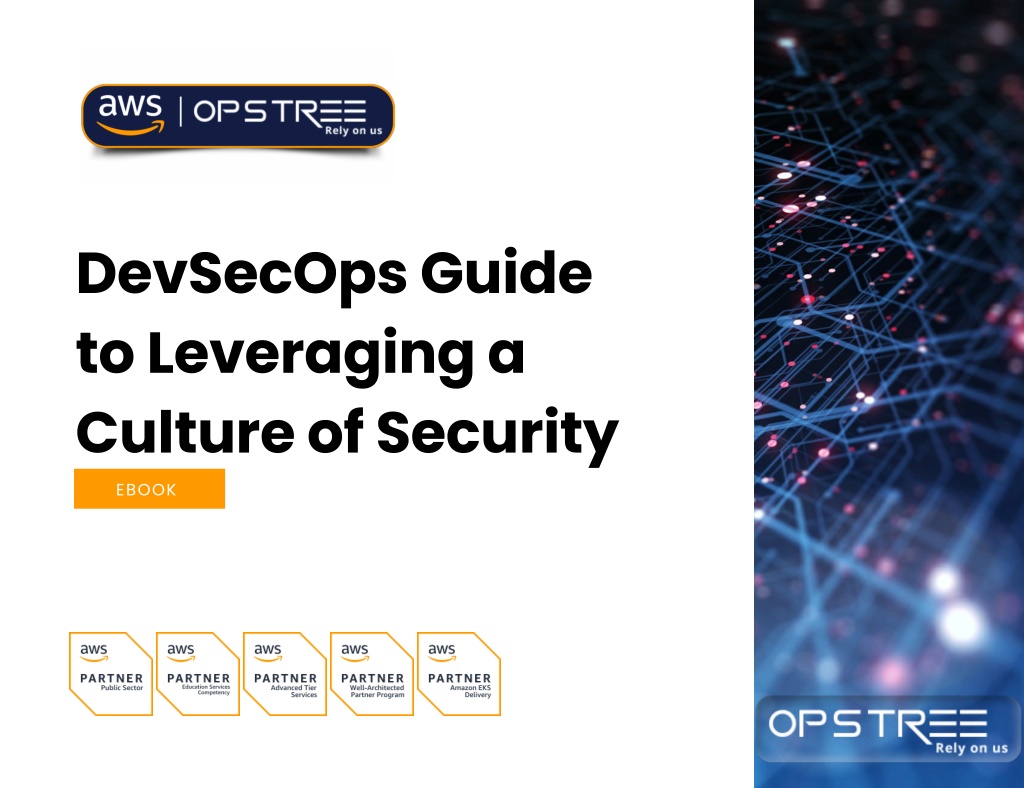
DevSecOps Guide to Leveraging a Culture of Security
Our DevSecOps services empower your teams to deliver secure software faster. Our automated security checks, compliance audits, and expert guidance ensure that your software is protected from vulnerabilities and meets the highest industry standards.
Download Presentation

Please find below an Image/Link to download the presentation.
The content on the website is provided AS IS for your information and personal use only. It may not be sold, licensed, or shared on other websites without obtaining consent from the author. If you encounter any issues during the download, it is possible that the publisher has removed the file from their server.
You are allowed to download the files provided on this website for personal or commercial use, subject to the condition that they are used lawfully. All files are the property of their respective owners.
The content on the website is provided AS IS for your information and personal use only. It may not be sold, licensed, or shared on other websites without obtaining consent from the author.
E N D
Presentation Transcript
DevSecOps Guide to Leveraging a Culture of Security EBOOK
Table of contents 3 4 5 8 11 12 14 17 18 19 20 Introduction Why develop a culture of security? How to develop tenets What does a culture of security look like? Designing for security in AWS Cloud An end-to-end pipeline of secure delivery and deployment Migrate and modernize with confidence About OpsTree Benefits of working with OpsTree Case study Learn more EBOOK 2
Organizational culture-shared values, mindsets, and behaviors that guide all employees-has everything to do with how successful an organization can be. Smaller teams within the business can adopt a specific culture that guides decisions on their focus area. A culture of security applies across a business from everyday best practices to developing modern applications in the cloud. In this eBook, you ll discover how AWS enables you to start creating a culture of security by combining your organization s own guiding principles and the DevOps philosophy of working. You ll explore how this approach impacts modernization and development strategies, and you ll learn how to build a pipeline of continuous integration and development that elevates every level of the business. EBOOK 3
Why develop a culture of security? A culture of security unites employees on a common path to business stability and modernization. Organizations that are migrating to the cloud as a step toward modernizing must adopt an entirely new mindset around security and start to better leverage modern technologies and operational models, such as DevOps. DevOps bringing together formerly siloed development and operations teams is a combination of cultural philosophies, practices, and tools that merges software development with information technology (IT) operations. DevOps enables companies to accelerate delivery of new application features and improved services to customers. DevSecOps integrates security processes into the DevOps model. With DevSecOps, businesses can rapidly deliver secure and compliant application changes while running operations consistently with automation. This starts with developing operating tenets they can apply when shaping their vision for security as their business evolves. EBOOK 4
How to develop tenets When updating their security culture, successful organizations ensure that everyone understands the need for change and the path to reaching their common goal. Crucial steps in developing actionable tenets include: Working with all employees to identify the organization s core values that serve as the foundation for the tenets. Establishing guidelines, expectations, and accountability for following the tenets while empowering every team to follow them. Garnering company-wide buy-in for the tenets and the new culture they support. At the highest level, each tenet should: 1. Be memorable. 2. Relay only a single idea. 3. Be specific to a program (e.g., security). 4. Guide, not proscribe. 5. Keep the business focused on the overall goal. EBOOK 5
How to develop tenets To guide their decisions and actions, businesses can apply the AWS-created tenets below. Organizations with an established culture of security with DevSecOps use the most common tenets to address: Constant attacks Build the understanding that the business is constantly under attack both deliberately and accidentally into every process. Education Prioritize security education for all employees. Stay abreast of developing threats, accept advice from security specialists, and seek to understand the organization s security policies and rules. Hygiene Evangelize company-wide that good security hygiene is part of doing things right. Do not share passwords or user accounts or expose personal information. Use secure coding practices. Continuous improvement After an error in protocol, take feedback to ensure it doesn t happen again. Zero-defect approach Do not accept any known vulnerabilities. Do not triage security defects and problems: Fix every issue as soon as it arises. EBOOK 6
How to develop tenets Reusable tools Build and share security tools and processes such as reusable logging and monitoring, enterprise-wide user provisioning, and standardized onboarding and offboarding processes for employees across all IT systems. Unified team Ensure that all parts of the organization collaborate to strengthen security and enable resilient systems. Testing Rigorously test systems for vulnerabilities with automation including failure scenarios and quality of response both during development and production. Threat modeling Think as bad actors do to identify possible entries to attack, and then test to defend against them. Peer reviews Consider any possible defects and security vulnerabilities in the work and ensure peers always review the code. Learn more about how tenets come into play on a cloud journey. EBOOK 7
What does a culture of security look like? In an established culture of security, an organization educates every employee in how to detect a potential threat, minimizes risk, and establishes a recovery plan. By acting proactively rather than reactively, the business is better positioned to protect themselves, their products and services, and their customers. Below are just a few examples of what a culture of security looks like in action. Employee-exposed passwords Today IT resets password(s), updates anti-virus software, and sends employee a link to reread the organization s security policy. In a culture of security Multi-factor authentication (MFA) is set by the organization; even though the password was exposed, the account is not compromised as a second factor is required to authenticate. The user will reset their own password and notify IT of the incident. Employee-exposed-exposed passwords EBOOK 8
What does a culture of security look like? Hacked customer loyalty database Today A phishing email with undetected malware exposes thousands of customer credit cards. In a culture of security Users are aware that email phishing is a threat, and don t click or respond to potentially malicious content. Additionally, the user reports the questionable email to the organization s security team. Unauthorized internal access to data Today The organization defaults to granting employees full access to internal data. In a culture of security The organization establishes identity and access management practices (IAMs) that limit an employee s access to only need-to-know data. Employee-exposed-exposedpasswords EBOOK 9
What does a culture of security look like? Skunkwork cloud infrastructure projects Today The dev team cuts a ticket and gets a help desk request to provision a cloud instance for staging. In a culture of security The team uses a cloud formation template that includes security policies and governance, then provisions the cloud on that automated script. Code typo Today After being informed of the software failure, the business releases a patch that users must download from the website and manually install. In a culture of security DevSecOps team undergoes threat detection and modeling during software development; if a fix is required, the business automatically pushes it out to registered users. EBOOK 10
Designing for security in the AWS Cloud After identifying and evangelizing their tenets through the business, the next step is to align them with design principles that guide security in their cloud strategy. Below are design principles that can help strengthen workload security. Implement a strong identity foundation Enable traceability Apply security at all layers Automate security best practices Protect data in transit and at rest Restrict unauthorized access to data Prepare for security events "The most popular misconception about moving to the cloud is that it s a set-and-forget proposition. Everything will run like clockwork, right? Instead of falling into this trap, [businesses] should be thinking about what happens on Day 2 the day after the last server has been decommissioned, and everything is fully running in the cloud and what [their] cloud governance strategy will be. " Dr. James Bland Global Technology Lead for DevOps, Amazon Web Services (AWS) EBOOK 11
An end-to-end pipeline of secure delivery and deployment After an organization develops and rolls out their tenets and design principles, they re ready to set in motion their DevSecOps pipeline, which is critical to building a successful software factory that includes continuous: Integration (CI). Delivery and deployment (CD). Testing. Logging and monitoring. Auditing. Governance. Operations. Identifying vulnerabilities during the initial stages of the software development process can significantly help reduce the overall cost of developing application changes, but doing it in an automated fashion can accelerate the delivery of these changes as well. EBOOK 12
An end-to-end pipeline of secure delivery and deployment Leveraging AWS To identify security vulnerabilities at various stages, organizations can integrate various tools and services (both cloud and third-party) into their DevSecOps pipelines. The advantage of AWS native tools and partner integrations is the ability to template an organization s CI/CD pipeline as infrastructure and scale it in the cloud. Organizations that build cloud-native applications can leverage services and AWS Software Developer Kits (SDKs) so they don t have to reinvent the wheel when working around technical limitations. Integrating various tools and aggregating the vulnerability and security findings from scratch can be a challenge. AWS has the services and tools necessary to accelerate this objective and provides the ease and flexibility to build DevSecOps pipelines by integrating AWS cloud-native and third-party tools. The AWS DevSecOps pipeline reference architecture illustrates these DevSecOps practices including Software Composite Analysis (SCA), Static Application Security Testing (SAST), Dynamic Application Security Testing (DAST) and the aggregation of vulnerability findings into a single pane of glass. EBOOK 13
Migrate and modernize with confidence: The DevSecOps journey step by step Start the DevSecOps journey with this step-by-step guide. 1. Undergo threat modeling Define any threat vectors: What will move to the cloud in the next18 months? How many points of entry are there? How does the business secure data in transit and data at rest? Outcome: An established point-in-time state of the state. It s important to note that the business will continually add variables during the transformation. EBOOK 14
Migrate and modernize with confidence: The DevSecOps journey step by step 2. Upskill, enable, and empower all teams Having an excellent security posture means having teams that are constantly on top of all threats across the infrastructure with a focus on continuing education. Security is a constantly moving target and a shared responsibility among all teams: developer, operations, security, and non-IT. Outcome: A detailed plan to upskill teams and shape the culture around collaboration to meet the organization s ever- changing security needs. 3. Implement a continuous security feedback loop across all stages of the delivery lifecycle Establish and evangelize best practices around security coding standards, integrated security testing models for all pipelines, application security testing(AST), and vulnerability management. Outcome: Issue identification during code development and feedback loops, which helps accelerate remediation and reduce costs. EBOOK 15
Migrate and modernize with confidence: The DevSecOps journey step by step 4.Establish policies and governance It s critical to ensure the business follows their policy and governance guardrails .Automate security policies to notify and remediate any violations or abnormalities. Outcome: Well-defined policy, governance, and automated remediation across the infrastructure and applications. 5.Gamify security and make it fun! Consider implementing bug bounties for development, operations, and security teams. It s a fun way to drive education and collaboration and to incentivize a security mindset and help meet education and upskilling goals. Outcome: An engaged, always-on security focus with an element of fun. EBOOK 16
About OpsTree A Trusted Digital Transformation & Data Engineering Partner OpsTree is a decade-old trusted Tech Partner, globally recognized as a pioneer in making application delivery lean, nimble, and highly productive through the best-in-breed cloud (Public, Private/Hybrid) and DevOpSecOps platform implementations alongside robust data engineering. Our expertise spans across Cloud & Security, DevOps & SRE, Testing & Automation, Data & Analytics, and MLOps AIOps. More than 150+ startups, mid-size enterprises, and big behemoths rely on OpsTree s top-of-the-league DevSecOps capabilities and services to reduce effective costs and complexity while boosting their productivity. Being an advanced AWS partner, OpsTree has enabled end-to-end cloud strategies for advanced performance, scalability, and cost reduction for some of the most recognized organizations on the planet. At OpsTree, we are committed to simplifying complex processes and delivering exceptional business growth for our clients. Because we believe in Possibilities. Reimagined EBOOK 17
Benefits of working with OpsTree For organizations Digital transformation is often the gateway to possibilities. At OpsTree we make even possibilities reimagine with our innovation and expertise!! Unparallel DevSecOps expertise When it comes to DevSecOps service and solutions OpsTree is one most the leading players in the Industry. Our expertise in implementing and optimizing DevOps practices for organizations often leads to improved software development speed, efficiency, and reliability. Secure and Scalable End-End Solutions. We are at every touch point of the software delivery cycle. Our expertise spans across Cloud & Security, DevOps & SRE, Testing & Automation, Data & Analytics, and MLOps AIOps. You don t have to look for multiple vendors when you have the right one! Tailored Solutions We don t believe in one-size-fits-all solutions, because every business has unique needs. We tailor our solutions for clients according to their business needs. Because for us it's always about winning together! EBOOK 18
An AI-powered content Challenge The client faced various challenges like high AI hosting costs, API timeouts during traffic surges, and migration challenges due to lack of expertise. The production server ran at 100% CPU utilization, the analytics dashboard suffered database corruption with large data volumes, and frequent DOS and DDoS attacks disrupted platform manageability. Solution OpsTree revamped the platform architecture, set up AWS infrastructure, and shifted from RDS to EC2 with master-slave servers. A VPN was implemented to filter malicious traffic, and a load balancer routes traffic to EC2 instances. IPv6 was added for performance, with slave parameters CPU over-utilization was reduced. Two server backups ensured Outcome OpsTree's solution resulted in a 50% cost optimization and an 80% reduction in malicious traffic . The production server saw a 70% reduction in CPU utilization , and DOS & DDoS attacks were completely eliminated. The platform achieved a seamless migration to Amazon EC2, a reliable analytics dashboard , and fail-proof API calls. EBOOK 19
Learn more Why AWS for DevOps? https://aws.amazon.com/devops/ Security Group Strategy for AWS https://opstree.com/blog/2024/06/18/security-group-strategy- for-aws/ AWS Firewall- Samurai Warriors Database Migration Service in AWS https://opstree.com/blog/2023/06/20/database-migration-service-in-aws/

